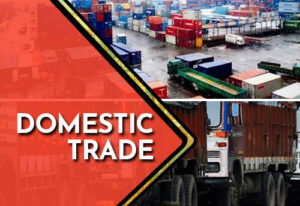“Discover the dynamic trends shaping the future of domestic trade in this comprehensive guide. From the e-commerce revolution to supply chain resilience and sustainable practices, explore recent updates and insights into the evolving landscape of domestic trade. Gain valuable insights to navigate the changing market dynamics and unlock opportunities for growth and success.”
Introduction:
Domestic trade serves as the backbone of a nation’s economy, facilitating the exchange of goods and services within its borders. From local markets and retail stores to wholesale distribution networks, domestic trade encompasses a diverse array of transactions that drive economic growth and prosperity. In this comprehensive blog, we’ll explore eight dynamic trends shaping the future of domestic trade, incorporating recent updates and insights into this vital sector of the economy.

E-commerce Revolution: Reshaping Retail Landscape:
The e-commerce revolution has transformed the retail landscape, redefining how consumers shop and businesses operate. Recent updates highlight the exponential growth of online retail platforms, fueled by changing consumer preferences and advancements in technology. From digital marketplaces and mobile shopping apps to social commerce and livestreaming sales, e-commerce has become an indispensable channel for domestic trade. As businesses embrace omnichannel strategies and invest in digital infrastructure, e-commerce continues to drive innovation and expansion in domestic trade.
Supply Chain Resilience: Navigating Disruptions:
The COVID-19 pandemic exposed vulnerabilities in global supply chains, prompting a renewed focus on supply chain resilience in domestic trade. Recent updates underscore efforts to diversify supply sources, enhance inventory management, and adopt agile logistics solutions to mitigate disruptions. From just-in-case inventory strategies to nearshoring and localization initiatives, businesses are rethinking their supply chain strategies to build resilience and adaptability. As supply chain disruptions persist, the quest for resilience remains a top priority for domestic trade stakeholders.
Sustainable Practices: Meeting Consumer Demand:
Sustainability has emerged as a key driver of consumer behavior, influencing purchasing decisions and shaping market trends in domestic trade. Recent updates highlight growing demand for eco-friendly products, ethical sourcing, and transparent supply chains. From sustainable packaging and fair trade certifications to carbon-neutral initiatives and circular economy models, businesses are embracing sustainable practices to meet consumer expectations and drive competitive advantage. As sustainability becomes increasingly intertwined with profitability, businesses are prioritizing environmental and social responsibility in domestic trade.

Digital Transformation: Enhancing Efficiency:
Digital transformation is revolutionizing operations and processes across the domestic trade ecosystem, unlocking new opportunities for efficiency and growth. Recent updates showcase the adoption of digital tools and technologies, such as cloud-based inventory management systems, artificial intelligence (AI)-powered analytics, and Internet of Things (IoT)-enabled tracking devices. From streamlining procurement processes to optimizing distribution networks, digital transformation is enhancing productivity, reducing costs, and improving decision-making in domestic trade. As businesses harness the power of data and technology, they gain a competitive edge in an increasingly digital marketplace.
Rise of Direct-to-Consumer (DTC) Brands: Disrupting Traditional Channels:
The rise of direct-to-consumer (DTC) brands is disrupting traditional distribution channels and reshaping the competitive landscape in domestic trade. Recent updates highlight the success of DTC brands in bypassing intermediaries and establishing direct relationships with consumers. From online-first startups to established brands launching DTC initiatives, businesses are leveraging digital platforms and social media marketing to reach customers directly. By offering personalized experiences, transparent pricing, and agile product development, DTC brands are capturing market share and driving innovation in domestic trade.
Local Sourcing and Regionalism: Supporting Communities:
The COVID-19 pandemic has sparked a renewed appreciation for local sourcing and regionalism in domestic trade. Recent updates showcase the resurgence of local markets, community-supported agriculture (CSA) programs, and artisanal goods movements. From farm-to-table initiatives to locally made products and neighborhood retail stores, businesses are prioritizing local sourcing to support communities and reduce dependence on global supply chains. By fostering partnerships with local suppliers and embracing the “buy local” ethos, businesses contribute to economic resilience and community development in domestic trade.
Regulatory Reforms: Facilitating Trade Facilitation:
Regulatory reforms play a crucial role in shaping the regulatory environment and facilitating trade facilitation in domestic trade. Recent updates highlight efforts to streamline trade procedures, reduce bureaucratic barriers, and enhance transparency in regulatory frameworks. From digital customs declarations and electronic invoicing to harmonized standards and trade agreements, policymakers are implementing measures to promote ease of doing business and foster competitiveness in domestic trade. By creating a conducive regulatory environment, governments enable businesses to thrive and drive economic growth in domestic markets.

Data-driven Insights: Informing Decision-making:
Data-driven insights are becoming increasingly valuable for businesses seeking to optimize operations and drive growth in domestic trade. Recent updates showcase the proliferation of data analytics platforms, market intelligence tools, and predictive analytics models. From analyzing consumer behavior and market trends to forecasting demand and optimizing pricing strategies, businesses leverage data-driven insights to inform decision-making and gain a competitive edge. By harnessing the power of data, businesses can identify opportunities, mitigate risks, and stay ahead of the curve in domestic trade.
Conclusion:
The future of domestic trade is characterized by dynamic trends that are reshaping the way businesses operate, consumers shop, and economies grow. From the e-commerce revolution and supply chain resilience to sustainable practices and digital transformation, businesses must adapt to navigate the evolving landscape of domestic trade successfully. By embracing innovation, sustainability, and agility, businesses can unlock opportunities and drive growth in the dynamic world of domestic trade. As we embark on this journey of transformation, collaboration, and adaptation will be key to realizing the full potential of domestic trade in the years to come.
Disclaimer:
The information provided in this blog is for general informational purposes only. While we strive to present accurate and up-to-date information, we make no representations or warranties of any kind, express or implied, about the completeness, accuracy, reliability, suitability, or availability of the information contained herein. Any reliance you place on the information provided is strictly at your own risk. We are not liable for any losses or damages arising from the use of the information in this blog. It is recommended to consult with professionals or experts in the field for specific advice tailored to your individual circumstances.




